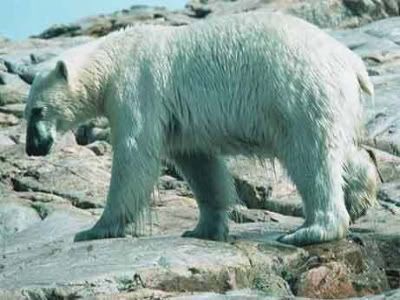
THE POLAR BEAR is the world's largest land predator. Its thick, waterproof fur coat and layer of blubber keeps it warm and enables it to swim for hours in freezing Arctic seas. So effective is the polar bear's insulation, in fact, that adult males quickly overheat when running. Polar bears spend most of the year floating on massive ice floes, covering daily distances of up to 40 km (25 miles) in a constant quest for food. In a lifetime, they may cover an area equal to 260,000 sq km (100,000 sg miles).
Long-distance Swimmers
Polar bears are champion swimmers and can paddle more than 100 km (60 miles) without a rest. To wring water out of their fur, they drag themselves across the ice. They keep clean as matted, dirty fur is a poor insulator. On bitterly cold days, polar bears dig a shelter and curl up tightly, sometimes covering their muzzle, which radiates heat, with a paw. Bears displaying submissive behaviour are often allowed to share a kill. To beg food from another bear, a polar bear approaches slowly, circles and offers a tentative nose-to-nose greeting.
New Age Threats
An agreement to restrict hunting and protect polar bear habitats was signed by Canada, the USA, Denmark, Norway and the former USSR in 1973. The population stabilized at 25,000 but remains vulnerable to global warming. This causes ice to melt earlier in summer and freeze later in winter, giving bears less time to hunt seals. Pollution from mineral exploitation is another concern. Pollutants may be responsible for some female polar bears growing male sex organs.
Waiting Game
Mating occurs during the spring but through a remarkable process called 'delayed implantation', embryo development goes on hold until late autumn. Then, provided the female has enough fat reserves, she digs a maternity den in which to hibernate and give birth. If she does not have adequate reserves, the embryo is re-absorbed. Cubs, which are roughly hamster-sized when born, are fed by their mother for at least two years.
Patience Pays
With their acute of smell and excellent underwater vision, polar bears hunt among shoreline ice floes. They often wait for hours by a seal's breathing hole, then as it surfaces, they pounce and kill it with a single bite to the head or a blow from their massive, heavy paws. Polar bears depend on the presence of ice for access to seals. In summer when floes retreat north, they travel hundreds of kilometres for food.
STATISTICS
Status : Lower risk
Social Unit : Individual
Length : 2.1 - 3.4 m (7 - 11 ft)
Weight : Male, 400 - 680 kg (880 - 1,500 lb); female weight 50% less
Migration : May migrate south in winter; returns in summer when the ice breaks up
Sexual Maturity : Female, 4 - 5 years; male, 8 years
Mating season : Spring
Gestation Period : 8 - 9 months
Number Of Young : 1 - 4; commonly 2
Breeding Interval : 3 years
Diet : Mainly seals, but also seabirds, fish, small mammals and bird's eggs
Lifespan : 20 - 25 years




0 comments:
Post a Comment